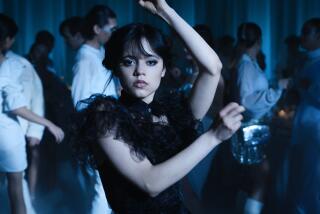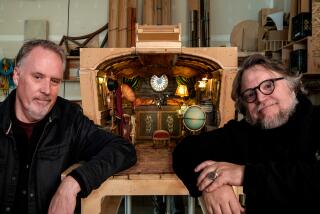From the Archives: Burton dreams up a delightful ‘Nightmare’
Editors note: “The Nightmare Before Christmas In Concert” will take place at the Hollywood Bowl from Oct.26-28 to celebrate the 25th anniversary of Tim Burton’s stop-motion animated musical. Below is film critic Kenneth Turan’s review, which ran in The Times on Oct. 15, 1993.
Forget “Beetlejuice,” forget “Edward Scissorhands” and (this shouldn’t be too difficult) forget “Batman Returns.” “Tim Burton’s The Nightmare Before Christmas” is the movie this decidedly quirky filmmaker was fated to make. Part avant-garde art film, part amusing but morbid fairy tale, it is a delightfully ghoulish holiday musical that displays more inventiveness in its brief 75 minutes than some studios can manage in an entire year.
Though it is an animated film, “Nightmare” is not a cartoon like “Aladdin” or “Beauty and the Beast.” Rather, on the model of the original “King Kong” and the more recent Speedy Alka Seltzer, it is a revolutionary application of stop-motion animation, a labor-intensive process that involves the frame-by-frame manipulation of three-dimensional creatures.
And though it managed to be rated PG (for some scary images), the aptly named “Nightmare” is definitely not a film for tiny tots. Although its soul is sweetness itself, its surface is disturbing and intentionally so, and its clever and satiric sense of humor is undoubtedly pitched to adult tastes.
“Nightmare’s” first incarnation was as a hand-drawn send-up of the Clement Moore poem that Burton created more than a decade ago, when he was working as a humble animator at the Walt Disney studios and dreaming of turning his idea into a TV special along the lines of “How the Grinch Stole Christmas.”
In the way it details what happens when the weirdos who run Halloween decide to expand and take over Christmas as well, “Nightmare” was deemed too bizarre for public consumption, but Burton never gave up on it. His increased box-office clout, courtesy of the “Batman” films, helped persuade Disney to green-light what may be the most personal piece of animation — and one of the most personal films, period — ever to come out of that studio.
Although someone else (“The Secret Garden’s” Caroline Thompson) ended up writing the script, and the technical nature of stop-motion animation meant that a drop-dead expert (Henry Selick) had to be hired to direct, “Nightmare’s” sensibility is clearly all Burton.
A live-action filmmaker with the soul of an animator, Burton has a taste for off-center, gruesome comedy — so off-putting when attached to real people, as it was in “Batman Returns” — but perfectly suited to these characters. Puppets, it should come as no surprise, make much better puppets than people ever could.
The premise of “The Nightmare Before Christmas” is the quaint one that everyone responsible for a particular holiday lives in the same self-contained enclave, cheerfully oblivious to the existence of rival festivities and other towns.
The residents of Halloweentown, for instance, are glimpsed celebrating another successful night of fright. Characters such as Big Witch, Corpse Mom and Clown With the Tear Away Face congratulate one another on a job well done while assuring us, in Danny Elfman’s lightly charming lyrics, “That’s our job, but we’re not mean / In our town of Halloween.”
Things don’t look so cheery for Jack Skellington, the Pumpkin King and spiritual head of Halloween Night. Though he’s the best at what he does, Jack has, sad to relate, “grown so weary of the sound of screams” and is in fact in the throes of a serious fit of existential boredom.
While wandering around in spiritual despair, Jack literally stumbles into Christmastown and is blown away by how bright and shiny everything is. “There’re children throwing snowballs here instead of throwing heads,” he sings exultantly in another one of Elfman’s 10 songs. “They’re busy building toys, and absolutely no one’s dead.”
Resentful that these clowns, so to speak, should have all the fun, Jack determines to take Christmas over from the fat round man he calls Sandy Claws and bring it all back home for the gang in Halloweentown to improve on. “This year,” he declares, “Christmas will be ours.”
Of course, as the intrepid Sally, the rag doll who loves Jack from afar, realizes, this won’t be so easy to do. But Jack, with the evil Dr. Finklestein (Sally’s crabby creator) and the malicious trio of Lock, Shock and Barrel to do his bidding, is blind to the difficulties he has in store. Until ....
Bringing this genially demented world to life meant solving two different but interlocking problems. First off, Burton’s drawings had to be turned into three-dimensional figures, and that has been done brilliantly. “Nightmare’s” crones, ghouls and grotesques — topped off by the ultimate incarnation of evil, the Oogie Boogie man (wonderfully served by Ken Page’s jazzy phrasings) — are completely beyond description. And even if they weren’t, it wouldn’t be fair to ruin the fun of having them pop up unexpectedly in their own disturbing way.
The other problem was making everybody move. Given that each second of on-screen action involves 24 different frames, and possibly 24 separate character movements, the amount of painstaking planning and grinding work involved in this was daunting. To ensure a variety of expressions for Jack, for instance, 800 different replaceable heads were made. No wonder that at maximum efficiency, the “Nightmare” crew could turn out no more than 70 seconds of finished film per week.
What they did turn out, however, is so profligate with exotic images that it overflows with a demented kind of genius, taking stop-motion to places it’s never been before. Prime mover Burton has written that “ ‘Nightmare Before Christmas’ is deeper in my heart than any other film,” and those who are the tiniest bit twisted will find a similar place for it in theirs as well.
‘Tim Burton’s The Nightmare Before Christmas’
Danny Elfman: Jack (singing)
Chris Sarandon: Jack (speaking)
Catherine O’Hara: Sally
William Hickey: Dr. Finklestein
Glenn Shadix: Mayor
Ken Page: Oogie Boogie
Ed Ivory: Santa
A Burton/Di Novi production, released by Touchstone Pictures. Director Henry Selick. Producers Tim Burton, Denise Di Novi. Co-producer Kathleen Gavin. Screenplay Caroline Thompson, adaptation by Michael McDowell, based on a story and characters by Tim Burton. Cinematographer Peter Kozachik. Animation supervisor Eric Leighton. Editor Stan Webb. Music and lyrics Danny Elfman. Art director Deane Taylor. Running time: 1 hour, 15 minutes.
MPAA-rated PG (some scary images).
More to Read
The biggest entertainment stories
Get our big stories about Hollywood, film, television, music, arts, culture and more right in your inbox as soon as they publish.
You may occasionally receive promotional content from the Los Angeles Times.











